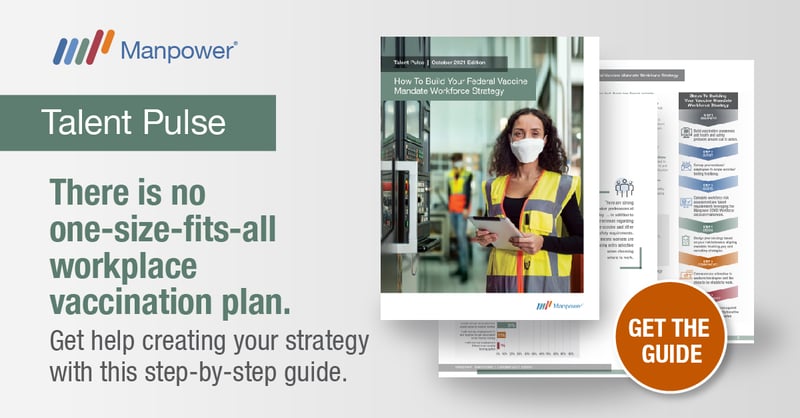
Omicron is impacting your workforce.
Here’s how to navigate the
latest wave.
of this Talent Pulse Briefing.
The current situation is very fluid
This more contagious variant of COVID-19 is still spreading in many parts of the country, and peaking in others. Governments, schools, and other organizations are putting cautionary measures in place like slowing travel, shifting to virtual meetings, and limiting non-essential guests. Companies are again trying to navigate increased employee absences and no-shows without sacrificing productivity. Don’t worry though – we have the insight to help you manage your workforce in these evolving, yet uncertain times.
Other factors are still in play
The U.S. Supreme Court blocked a rule that would require large employers to mandate the COVID-19 vaccine or undergo testing, and on January 25, 2022, the Occupational Safety and Health Administration (OSHA) withdrew its requirement for large employers. In the wake of this decision, companies will need to ensure they are adopting or maintaining a policy that works best for their workforce and also consider the evolving state and municipal restrictions.
Supply chain issues are not going away. As of January 2022, there are more anchored, loitering and slow-speed container ships in the vicinity of Los Angeles and Long Beach ports than at any time on record. Experts also feel that supply chain problems will resolve in 2022 through vaccination, more capital spending on infrastructure and a shift in spending from goods back to services. But for the time being, manufacturers are being forced to scramble as they wait for raw material or component parts to arrive..png?width=800&name=MicrosoftTeams-image%20(12).png)
What happened to job candidate activity during previous waves?
According to our research, during previous waves of the virus, we saw a slight decrease in the number of candidates recruited, screened and matched, with ultimately a 3% decrease in job candidates placed on assignment. Though a small impact could be felt, we do not anticipate a significant downturn in our candidate flow with the onset of Omicron.
The above chart depicts the market turnover as we correlate the data with job openings and our client insight. Note that there were two peaks in the summer during Delta variant spikes, but that market turnover fell from October through early December – just before the impacts of Omicron began to be felt.
As we move into Wave 3, experts including Anthony S. Fauci, M.D., Director of National Institute for Allergy and Infectious Disease (NIAID)1, are saying that this wave should peak throughout the country by mid-February. We think that the labor supply will hold due to the lack of economic stimulus payments this time, along with dwindling personal savings, and in many cases, higher wages.
Employer Watch-Outs in Wave 3
Sick days may increase
Many states are setting records for new Covid cases and in many cases, hospitalizations. This is already resulting in new labor shortages. In addition, while worker burnout continues to be high, Gallup found that employees who report frequently being burned out at work are 63% more likely to take a sick day.
Absenteeism on the rise
As individuals may experience symptoms of illness, find themselves quarantined with a family member, or find their children’s schools are once again returning to virtual learning, we are likely to see an increase in absenteeism. In addition, workers who feel anxious or that their worksite is unsafe may be at more risk for no-shows. Clear policies, procedures and communications are critical for employers to proactively mitigate no call/no shows. Revisit, strengthen and redeploy the safety protocols and communication plans you created/executed in prior waves.
In reviewing workforce behavior, we have seen absenteeism amongst workers increase as much as 90% from previous months in just the first few weeks of January 2022.
Productivity rate will be affected
During peak COVID periods, absenteeism led to drops in utilization rate, the number of hours an individual works against the number of available hours they have to work. This inevitably leads to lower productivity, so employers should be preparing for solutions to address lower utilization rates in the next couple of months. However, in a move that could significantly lessen the impact, the Centers for Disease Control and Prevention (CDC) has now shortened quarantine times from 10 days to just five days. The wild card though, is whether schools will continue in-person or see-saw between in-person and remote, which has an immediate impact on caregivers.
Turnover is still a major challenge, but can be mitigated
While turnover rates remained relatively stable in Q4 2021, high churn is another mark of the economic recovery, as employer demand for talent surged and workers leave their jobs to take other opportunities. “Today we’re advising business leaders to focus less on what’s new and more on what’s ending - the end of the minimum wage as we know it, the end of employees
choosing work over health, and the end of just in-time hiring,” said Becky Frankiewicz, President, ManpowerGroup North America. “The power dynamic still sits firmly in the hands of the worker and now is the time to redesign roles that are closer to what people want with flexibility, skills development and purpose front and center.”
In today’s labor market, workers are in the driver’s seat. Many report being burned out and are looking for more flexibility as they reshape their priorities. They are also seeking higher pay that more clearly reflects the value they believe they bring to the workplace. All these factors and more have been driving elevated turnover rates, a dynamic that has led to this period being coined The Great Realization. Manpower believes that the data points to the risk of increasing turnover remaining in this candidate-driven market as employees feel more empowered and may ‘jump ship’ to take advantage of higher wages and better benefits and perks offered by those companies who are investing in winning the talent war.
Combat turnover with competitive pay and other benefits
You can lower turnover by increasing pay rate
As this graph from our Manpower Workforce Insights tool shows that with higher pay, turnover begins to decline, dropping in half at $18/hour..png?width=913&name=MicrosoftTeams-image%20(10).png)
We are seeing clients being able to drop turnover significantly by increasing pay from $14 to $18. Flexibility is also very important. A recent survey reveals that given a choice, most employees favor two days in the office and three days offsite. Beyond that, flexibility could take the shape of flexible shift options, or flexible start times to meet the preferences of your workforce.
Data varies widely by location. What works in one market may not work in yours. We can help you drill down to what is working in your market - not just in pay rates, but shift flexibility and rewards and incentives.
How you should plan
Revisit your commitment to the health and safety of workforce and workplace
Take into account your worker preferences. If you’ve surveyed your workforce – leverage that as you refresh and recommunicate policies and procedures. If not, consider a survey (as discussed in the November Talent Pulse.) A Manpower survey of workers showed that 24% of respondents (average hourly salary around $16) stated that they would not get vaccinated, but would submit to weekly testing. Another 11% said that they would not submit to vaccinations or weekly testing. However, these preferences vary widely by geography.
Revisit your communication plan from prior COVID spikes – and make sure that communication is 2-way.
That way, you can get under your employees’ concerns and share what you are doing to address them. Talent today expects to have a voice, and a lack of communication is likely to cause not only anxiety but reduce productivity.
Rethink job design
Today’s workers want better pay, but they also want better jobs.
Consider the kinds of factors that employees find valuable and that influence your ability to recruit and retain talent overall. We can help you measure your organization on the top four – competitiveness (pay), environment, culture and career advancement pathways – and see how you stack up against your competitors, nationally and locally.
Revisit your overfill and refill strategy
In the face of potential increased absences during Wave 3 due to sickness and other reasons, consider how you will maintain a level of staff capacity that keeps production moving and your customers happy. Turnover remains a risk as candidates are empowered to rethink priorities and preferences and pursue new job opportunities that better fit their situation. Revisit your refill strategy and count on a workforce partner like Manpower to deliver access to an expanded pool of qualified talent and improved talent matches.
Connect with your workforce expert for a closer look at your organization. We can help you make the smartest decision for your organization to navigate the next coronavirus wave.






Comments